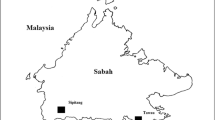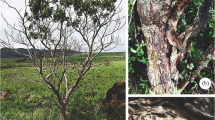Abstract
Among fungi in the Cryphonectriaceae, Cryphonectria parasitica, the causal agent of chestnut blight, and Chrysoporthe spp., inducing stem cankers and death of plantation-grown Eucalyptus spp., constitute some of the most important tree pathogens. During a survey to determine diseases and related pathogens associated with native and non-native Myrtales in Zambia, two fungi resembling stem canker pathogens in the genus Chrysoporthe were recovered from Syzygium guineense and Eucalyptus grandis. We undertook this study to characterise the fungi, using DNA sequence comparisons and morphological features. Inoculation tests were also conducted in a greenhouse to assess their pathogenicity on Eucalyptus spp. Results showed distinct phenotypic differences between isolates collected from Zambia and existing species of Chrysoporthe, and phylogenetic analyses demonstrated that the Zambian isolates represent previously undescribed species of Chrysoporthe. These isolates, which have been named Chrysoporthe zambiensis sp. nov. and Chrysoporthe syzygiicola sp. nov., are only known from their anamorphic states. Both species were found to be pathogenic to Eucalyptus. The description of Chr. zambiensis and Chr. syzygiicola with teleomorph names, led to the new combination Chrysoporthe hodgesiana for the only anamorphic species in Chrysoporthe, Chrysoporthella hodgesiana, to ensure more stable and less confusing taxonomy for Chrysoporthe.





Similar content being viewed by others
References
Anagnostakis SL (1987) Chestnut blight, the classical problem of an introduced pathogen. Mycologia 79:23–37
Chidumayo EN (1997) Miombo ecology and management, 2nd edn. Stockholm Environment Institute, Sweden
Chipeta ME (1999) Forestry management and sustainable development in southern Africa. South Afr Dev Bull 10:14–17
Cunningham CW (1997) Can three incongruence tests predict when data should be combined? Mol Biol Evol 14:733–740
Darlu P, Lecointre G (2002) When does the incongruence length difference test fail? Mol Biol Evol 19:432–437
Dettman JR, Jacobson DJ, Taylor JW (2003) A multilocus genealogical approach to phylogenetic species recognition in the model eukaryote Neurospora. Evolution 57:2703–2720
Farris JS, Kallersjo M, Kluge AG, Bult C (1994) Testing significance of incongruence. Cladistics 10:315–319
Gibson AIS (1981) A canker disease of Eucalyptus new to Africa. FAO, Forest Resources Information 10:23–24
Glass NL, Donaldson GC (1995) Development of primer sets from filamentous ascomycetes. Appl Environ Microbiol 61:1323–1330
Gryzenhout M, Myburg H, Van der Merwe NA, Wingfield BD, Wingfield MJ (2004) Chrysoporthe, a new genus to accommodate Cryphonectria cubensis. Stud Mycol 50:119–142
Gryzenhout M, Myburg H, Wingfield BD, Montenegro F, Wingfield MJ (2005) Chrysoporthe doradensis sp. nov. pathogenic to Eucalyptus in Ecuador. Fungal Divers 20:39–57
Gryzenhout M, Wingfield BD, Wingfield MJ (2006a) New taxonomic concepts for the important forest pathogen Cryphonectria parasitica and related fungi. FEMS Microbiol Lett 258:161–172
Gryzenhout M, Rodas CA, Mena Portales J, Clegg P, Wingfield BD, Wingfield MJ (2006b) Novel hosts of the Eucalyptus canker pathogen Chrysoporthe cubensis and a new Chrysoporthe species from Colombia. Mycol Res 110:833–845
Gryzenhout M, Wingfield BD, Wingfield MJ (2009) Taxonomy, phylogeny, and ecology of bark-infecting and tree killing fungi in the Cryphonectriaceae. APS Press, Minnesota, USA
Heath RN, Gryzenhout M, Roux J, Wingfield MJ (2006) Discovery of Chrysoporthe cubensis on native Syzygium species in South Africa. Plant Dis 90:443–438
Heiniger U, Rigling D (1994) Biological control of chestnut blight in Europe. Phytopathology 32:581–599
Hodges CS, Alfenas AC, Ferreira FA (1985) The conspecifity of Cryphonectria cubensis and Endothia eugeniae. Mycologia 78:343–350
Katoh K, Misawa K, Kuma K, Miyata T (2002) MAFFT: a novel method for rapid multiple sequence alignment based on fast Fourier transform. Nucleic Acid Res 30:3059–3066
McNeill J, Barrie FR, Burdet HM, Demoulin V, Hawksworth DL, Marhold K, Nicolson DH, Prado J, Silva PC, Skog JE, Wiersema JH, Turkland NJ (2007) International Code of Botanical Nomenclature (Vienna Code) adopted by the Seventeenth International Botanical Congress Vienna, Austria, July 2005. Gantner, Ruggell. (Regnum Vegetabile, 146). XVIII, p 568
Micales JA, Stipes RJ, Bonde MR (1987) On the conspecifity of Endothia eugeniae and Cryphonectria cubensis. Mycologia 79:707–720
Möller EM, Bahnweg G, Sandermann H, Geiger HH (1992) A simple and efficient protocol for isolation of high molecular weight DNA from filamentous fungi, fruit bodies, and infected plant tissues. Nucleic Acids Res 20:6115–6116
Muimba-Kankolongo A, Nawa IN, Roux J, Ng’andwe P (2009) Damage to foliage and stems caused by fungal pathogens in young eucalypt plantations in Zambia. South For 71:171–178
Myburg H, Gryzenhout M, Heath RN, Roux J, Wingfield BD, Wingfield MJ (2002) Cryphonectria canker on Tibouchina in South Africa. Mycol Res 106:1299–1306
Nakabonge G, Roux J, Gryzenhout M, Wingfield MJ (2006) Distribution of Chrysoporthe canker pathogens on Eucalyptus and Syzygium spp. in Eastern and Southern Africa. Plant Dis 90:734–739
Nakabonge G, Gryzenhout M, Wingfield BD, Wingfield MJ, Roux J (2007) Genetic diversity of Chrysoporthe cubensis in eastern and southern Africa. S Afr J Sci 103:261–264
Nutman FJ, Roberts FM (1952) Acute dieback of clove trees in the Zanzibar Protectorate. Ann Appl Biol 39:599–608
Posada D, Crandall KA (1998) Modeltest: testing the model of DNA substitution. Bioinformatics 14:817–818
Rayner RW (1970) A mycological colour chart. Commonwealth Mycological Institute and British Mycological Society, Kew, Surrey, UK
Rodas CA, Gryzenhout M, Myburg H, Wingfield BD, Wingfield MJ (2005) Discovery of the Eucalyptus canker pathogen Chrysoporthe cubensis on native Miconia (Melastomataceae) in Colombia. Plant Pathol 54:460–470
Roux J, Myburg H, Wingfield BD, Wingfield MJ (2003) Biological and phylogenetic analyses suggest that two Cryphonectria species cause cankers of Eucalyptus in Africa. Plant Dis 87:1329–1332
Roux J, Meke G, Kanyi B, Mwangi L, Mbaga A, Hunter GC, Nakabonge G, Heath RN, Wingfield MJ (2005) Diseases of plantation forestry tree species in eastern and southern Africa. S Afr J Sci 101:409–413
Shakacite O (1991) A review of the pathology of Eucalyptus in Zambia. Research note No. 51. Division of Forest Research, Kitwe, Zambia
Sinclair WA, Lyon HH (2005) Diseases of trees and shrubs, 2nd edn. Cornell University Press, Ithaca, USA
Slippers B, Stenlid J, Wingfield MJ (2005) Emerging pathogens: fungal host jumps following anthropogenic introduction. Trends Ecol Evol 20:420–421
Sokal RR, Rohlf FJ (1995) Biometry: the principles and practices of statistics in biological research, 3rd edn. Freeman, New York
Swofford DL (2002) PAUP*. Phylogenetic analysis using parsimony *and other methods. Version 4.0b10. Sinauer Associates, Sunderland, Mass.
Van Heerden SW, Wingfield MJ (2001) Genetic diversity of Cryphonectria cubensis isolates in South Africa. Mycol Res 105:94–99
Vermeulen M, Gryzenhout M, Wingfield MJ, Roux J (2008) Cryphonectriaceae canker pathogens on native and non-native Myrtales in southern Africa. In Proceedings of the XXXIVth Annual Conference of the South African Association of Botanists SAAB 2008 and the VIIth Southern African Society for Systematic Biology SASSB. Drakensville Mountain Resort, KwaZulu-Natal, 13–18 January 2008
White TJ, Bruns T, Lee S, Taylor J (1990) Amplification and direct sequencing of fungal ribosomal RNA genes for Phylogenetics. In: Innis MA, Gelfand DH, Sninsky JJ, White TJ (eds) PCR protocols: a guide to methods and applications. Academic, San Diego, USA, pp 315–322
Wingfield MJ (2003) Daniel McAlpine Memorial Lecture. Increasing threat of diseases to exotic plantations in the Southern Hemisphere: lessons from Cryphonectria canker. Australas Plant Pathol 23:133–139
Wingfield MJ, Swart WJ, Abear BJ (1989) First record of Cryphonectria canker of Eucalyptus in South Africa. Phyophylactica 21:311–313
Wingfield MJ, Rodas C, Wright J, Myburg H, Venter M,Wingfield BD (2001) First report of Cryphonectriacanker on Tibouchina in Colombia. For Pathol31:1–10
Yang Z (1994) Maximum likelihood phylogenetic estimation from DNA sequences with variable rates over sites: approximate methods. J Mol Evol 39:306–314
Zimba SC (2005) The contribution of the forestry sector to the copper mining industry in Zambia. Proceedings from the First National Symposium on Timber Industry in Zambia. Mulungushi International Conference Centre. Lusaka, Zambia. 29–30 September 2005. pp 90–94
Acknowledgements
We acknowledge the assistance from Copperbelt Forestry Company (CFC), Zambia Forests and Forestry Industrial Corporation (ZAFFICO) and Zambian Forestry Department during collection of samples. Joha Grobbelaar and Pieter de Meyer are thanked for field assistance during the survey. Drs. Amy Rossman (BPI, USDA), David Hawksworth (Universidad Complutense de Madrid, Spain; Natural History Museum, London) and Walter Gams are thanked for advice on the use of Chrysoporthella and Article 59. We thank Dr. Hugh Glen for latin translations. This study was in part funded by the National Research Foundation (NRF) of South Africa through a grant for a collaborative research programme between FABI at University of Pretoria (South Africa) and School of Natural Resources at Copperbelt University (Zambia), and a scholarship for post-graduate studies to the first author.
Author information
Authors and Affiliations
Corresponding author
Rights and permissions
About this article
Cite this article
Chungu, D., Gryzenhout, M., Muimba-Kankolongo, A. et al. Taxonomy and pathogenicity of two novel Chrysoporthe species from Eucalyptus grandis and Syzygium guineense in Zambia. Mycol Progress 9, 379–393 (2010). https://doi.org/10.1007/s11557-009-0646-9
Received:
Revised:
Accepted:
Published:
Issue Date:
DOI: https://doi.org/10.1007/s11557-009-0646-9




